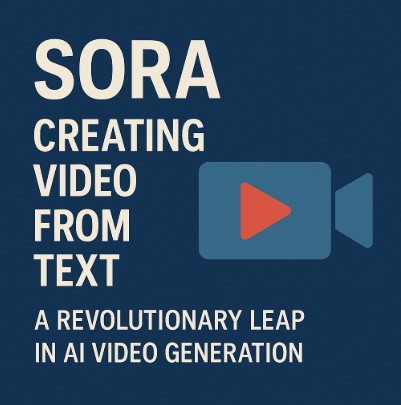The world of artificial intelligence is constantly evolving, and one of the most exciting recent advancements is the ability to generate videos from text. This was once the realm of science fiction, but now, thanks to innovative models like Sora, it’s becoming a reality. Sora represents a significant leap forward in AI video generation, offering unprecedented capabilities and opening up a world of possibilities for creative professionals, businesses, and researchers alike. This article delves into the fascinating world of Sora: creating video from text, exploring its functionality, applications, and potential impact.
Table of Contents
Understanding Sora: How It Works
Sora, developed by Meta AI, is a powerful AI model capable of generating high-quality videos directly from text descriptions. Unlike previous text-to-video models, Sora excels in its ability to produce long-form videos with complex scenes and detailed narratives. This is achieved through a sophisticated architecture that leverages advanced machine learning techniques. It’s not simply stringing together existing video clips; Sora generates entirely new video content, frame by frame, based on the input text prompt.
The Technology Behind Sora
The exact technical details of Sora’s architecture are complex and not fully public. However, it is known to utilize a combination of techniques, including:
- Large Language Models (LLMs): LLMs help Sora understand the nuances of the text prompt, interpreting the narrative, characters, settings, and desired visual effects.
- Diffusion Models: These models are used to generate the actual video frames. Diffusion models start with noise and iteratively refine it into a coherent visual representation based on the information provided by the LLM.
- High-Resolution Video Generation: Sora pushes the boundaries of video resolution and detail, creating remarkably realistic and visually appealing videos.
Advantages of Sora over Existing Technologies
Sora distinguishes itself from earlier text-to-video models through several key advantages:
- Longer Video Lengths: Sora can generate much longer videos than previous models, allowing for more complex storylines and narrative structures.
- Improved Visual Fidelity: Sora produces higher-resolution videos with greater detail and realism.
- Enhanced Scene Understanding: Sora demonstrates a more advanced understanding of complex scenes and spatial relationships, leading to more coherent and believable videos.
- Better Control over Narrative: Users have greater control over the narrative arc and character development in the generated videos.
Examples of Sora: Creating Video from Text
The capabilities of Sora are best illustrated through examples. Let’s explore a range of scenarios, from simple to complex:
Basic Example:
Text Prompt: “A fluffy white cat playing with a ball of yarn in a sunlit room.”
Result: Sora would generate a short video showing a realistic-looking white cat engaging playfully with a ball of yarn in a bright, sun-drenched room. The video would likely include subtle details like the cat’s fur texture, the yarn’s movement, and realistic lighting.
Intermediate Example:
Text Prompt: “A bustling city street scene at night, with neon lights reflecting on wet pavement, a lone figure walking quickly through the rain, and distant sirens wailing.”
Result: Sora would create a more complex video with multiple elements. It would accurately depict the atmosphere of a rainy city night, including reflections, rain effects, and the ambient sounds suggested in the prompt. The lone figure would be realistically animated, and the scene would exhibit depth and visual detail.
Advanced Example:
Text Prompt: “A dramatic chase scene through a dense forest, with a superhero effortlessly leaping over obstacles, pursued by a pack of ferocious wolves. The sun sets dramatically in the background, casting long shadows.”
Result: This example showcases Sora’s ability to handle complex action sequences, realistic character animation, and dynamic lighting effects. The video would be visually stunning, showcasing the model’s capabilities in creating a believable and engaging action sequence.
Applications of Sora: Creating Video from Text
The applications of Sora extend across numerous industries and creative fields:
- Film and Television: Sora can assist filmmakers in pre-visualization, creating storyboards, and generating initial footage for scenes, saving time and resources.
- Advertising and Marketing: Creating engaging and visually rich advertisements becomes significantly easier and faster. Businesses can tailor their ads to specific target audiences with greater efficiency.
- Education and Training: Sora can create educational videos explaining complex topics in a more engaging way. It can also generate simulations and training materials for various professions.
- Gaming: Sora can assist in creating cinematic cutscenes, character animations, and even entire game environments.
- Art and Design: Artists and designers can use Sora to bring their creative visions to life, generating unique and dynamic visual content.
Frequently Asked Questions (FAQ)
Q: Is Sora publicly available?
A: Currently, Sora’s availability is limited. Meta has not yet released it for public use. Access may be granted to select researchers and partners. However, future plans regarding public release are expected to be announced.
Q: How much does Sora cost?
A: The pricing model for Sora is not yet publicly known. This information will likely be released when the technology becomes more widely available.
Q: What are the limitations of Sora?
A: While impressive, Sora is still under development. Current limitations may include occasional inaccuracies in representing details, difficulties with complex physics simulations, and potential biases inherited from its training data. These limitations are expected to be addressed in future iterations.
Q: What about copyright and intellectual property?
A: The legal aspects of copyright and intellectual property concerning AI-generated content are complex and still evolving. It’s crucial to carefully review legal guidelines and regulations related to AI-generated video content before using it for commercial purposes.
Q: How can I learn more about Sora?
A: Keep an eye on Meta AI’s official website and publications for updates, news, and potential announcements regarding public access and further details on the technology. You can also follow leading AI research journals and publications for related articles.

Conclusion
Sora: creating video from text represents a groundbreaking advancement in AI-generated video technology. Its ability to generate long-form, high-quality videos directly from text prompts opens up incredible opportunities across diverse fields. While currently not publicly available, Sora’s potential impact is undeniable. As the technology evolves and becomes more widely accessible, we can expect to see a transformative effect on how videos are created, consumed, and utilized across various industries and creative endeavors. This is a pivotal moment in the evolution of AI and its integration with the world of visual media, and the future implications are both exciting and far-reaching.Thank you for reading the DevopsRoles page!
